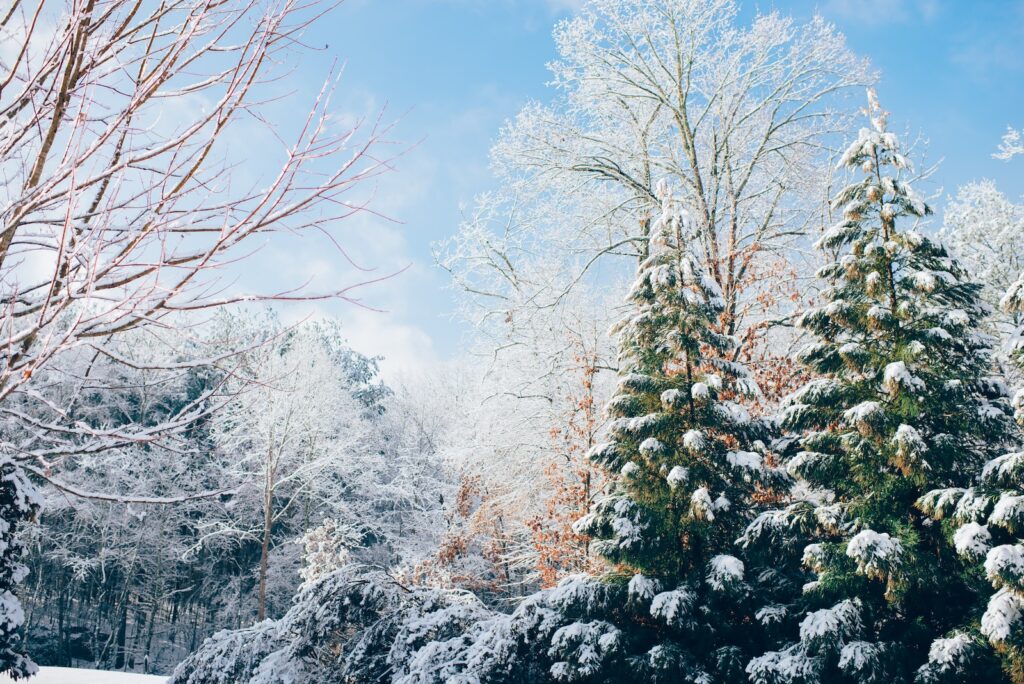13 Easy Ways to Study Nature in Winter
When the weather starts to get colder, do you find it more difficult to spend time outside? If so, then this list of ideas on how to study nature in winter is just for you!

This post contains affiliate links, meaning that I’ll earn a small commission (at no extra cost to you) if you make a purchase using these links. As an Amazon Associate I earn from qualifying purchases. See my disclosure page to learn more.
I love living in Maine, but winters here can be long and cold! There are many days when we don’t even want to venture outside! However, I try to keep in mind that despite the cold, it’s a great time of year to get outside and explore nature in winter!
Wintertime offers lots of opportunities for kids to learn about and experience the changes of the season, as well as the many interesting and unique things that can only be observed in winter. And while studying nature in winter may be a bit more challenging than during the rest of the year, it’s definitely worth it!
So if you’re looking for ideas on how to get the kids outside to study nature this winter, I’ve got you covered! Here are different ways that you and your child can learn more about this amazing season:
Ways to Study Nature in Winter
1. Take a winter hike
My kids and I enjoying going hiking all year round, but there is something special about hiking in the winter. The leaves are off the trees and you can see things that aren’t as easy to see any other time of year. Scholastic Watch and Learn has a short video about what changes we may be able to see in the winter, which you could watch before your hike (or anytime you want to learn more about winter!).
While on your hike, you can look for animal tracks, observe how the trees and plants are different, or see how many various animals you can find (or how many you don’t see anymore). And once you’re back home, your child can record what they saw and heard in their own nature journal (either a homemade one or a store bought journal will work).
For some added fun, try a full moon hike (or walk or snowshoe) and see how nature looks and sounds different at night versus during the day.
Plus, taking a hike is a great way to just spend some quality time together, even if you don’t talk about nature or fill out a journal. Getting some fresh air and exercise while creating memories is always a good thing! You could even add this activity to your winter bucket list!
2. Look for animal tracks
If you live where there’s snow on the ground, then this activity is a little easier, but it can also be done without snow. Just head outside and walk around your backyard, on nearby trails, or at a local park to see what kind of tracks you can find.
You can either record the size and sketch out what the tracks looked like in a nature journal or sketchbook, or take a picture and study it more when you get back home. See if you can figure out what animal made each track. If you want to learn more about how to track and what certain animal tracks look like, Nature Tracking has some helpful information.
If your child expresses more interest in animal tracks and how to identify them, here are some books they may enjoy:
There are also these fun resources if your child is really into animals and the tracks they make:
3. Go stargazing
Winter is a great time to go outside at night and look up at the stars. Since it gets dark so early, you can spend time together outside looking at the stars, and still make it back inside before bedtime!
Plus, you can see different constellations in the winter than you can in the summer. This is a great way to learn more about space and constellations. You can also bring along a map of the stars, or use an app on your phone to help identify the things you are seeing. Binoculars or a telescope add to the fun and make things easier to see, but they’re not necessary. You can still have fun stargazing without them!
For more helpful information on how to study nature in winter by stargazing, check out A Kid’s Guide to Stargazing on the website, Ology (a part of the American Museum of Natural History).
And here are some helpful books to use if you want to dig even further into the topic of stargazing and the night sky:
4. Observe the weather
Winter is a great time to observe nature and the changes in weather, regardless of the cold temperatures! From tracking snowfall amounts to watching how ice freezes – winter provides many opportunities for learning and exploration.
Encourage kids to look for patterns in the sky and observe changes like frosty mornings or ice-covered trees. Or record snowfall amounts, or the temperature and type of weather each day for a certain number of days. They can also draw pictures of what they see outside or write down observations in a journal so they can track changes over time.
And you can go beyond just observing weather too- ask questions like “how does snow form?” or “how are icicles made?” or “why does it get colder in the winter?” or “how does the cold weather affect plants, or animals?”
If you want to head outside for some winter weather cloud observing, then grab this FREE printable cloud viewer when you sign up below!

5. Study the snow
If you happen to live where it snows, then getting outside to learn more about that cold, white stuff is a great way to study nature in winter! Try catching snowflakes on black paper and then observing them with a magnifying glass. Or, learn about their different shapes and how no two snowflakes look alike. The book Snowman Bentley is a great book to read if you want to study snowflakes.
Another way to learn more about snow is to fill different sized measuring cups with snow and then bring them inside. Let the snow melt and then measure how much water it turned into once it’s all melted.
If you want more ideas or resources for studying the snow, look at these activities and nature studies:
- 35 Fun Snow Facts for Kids – by Well Beings with Alysia
- A Spectacular Snow Nature Study – by Deliberate Mom
- Exploring the Science of Snow – by Only Passionate Curiosity
- Snow Experiments – by Steamsational
- Snow Unit Study – by Loving Homeschool
- The Science of Snow – by Heart and Soul Homeschooling
- Games to Play in the Snow – by REI (this isn’t a study on snow, but instead fun games that you can play out in the snow – might as well have some fun while learning!)
- Snow and Ice: Winter Nature Study – by Our Journey Westward (this is not a free study, but it is a good choice if you are looking for a unit study to do this winter on snow or ice)
6. Study Ice
Learning about snow is fun of course, but another “cool” winter topic to study is ice! You can observe icicles and watch how they form, or how fast (or slow) they grow based on the weather. Or try freezing different sized containers of water and see how long it takes each one to freeze. This could also lead into learning about how we can use salt to melt ice.
Here are some additional resources to check out if you want to explore the topic of ice more:
- Science Experiments With Ice – by Fantastic Fun and Learning
- More Ice Science Experiments – by How Wee Learn
- Ice Science Experiments – by Steamsational
7. Learn about maple trees
I’m so thankful to live in a place that has a lot of maple trees because that means it’s easier to find fresh maple syrup! A family friend of ours taps maple trees and my kids and I always enjoy watching how syrup is made – and sampling the result of all that hard work!
Winter is a great time to learn more about maple trees and how they are used to make maple syrup. Below are some books and helpful resources on maple trees and syrup.
- Resources for Exploring Maple Syrup – by Stemhax
- Planning a Maple Sugaring Unit Study – by My Little Poppies
- 58 + Maple Syrup Unit Study Ideas – Homeschool Super Freak
- Maple Sugaring Winter Nature Study – by Everyday Graces Homeschool
8. Go on a winter scavenger hunt
Scavenger hunts are fun no matter what the season is, including winter! They add an extra element of fun to your nature walks or time spent outside. You can complete the scavenger hunt as a family, or if your kids like being competitive, have teams and see who can find all of the items first!
Make up a checklist of things to look for (or use a premade winter scavenger hunt like the free ones at The Crazy Outdoor Mama or Homeschool Share), grab a clipboard and pencil, and head outside to see if you can find all of the things on your list.
9. Study the trees
There are many different topics and directions you could go when it comes to studying trees in the winter. As mentioned earlier, you can learn more about maple trees and making syrup. But evergreen trees are another good topic. Go outside and see how many different types of evergreen trees you can find, or how they are different than trees that lose their leaves every fall. You can study the different kinds of needles or learn more about how these trees are used.
Here are some good unit studies for evergreen trees if you want to dive deeper into this topic:
- A Free Homeschool Unit Study: Evergreen Trees – by Wolfe Pack
- How To Enjoy An Evergreen Nature Study In Your Homeschool – by Homeschooling in Progress
- Learning About Conifer and Evergreen Trees – by Project Learning Tree
- Evergreen Nature Study – by For the Love of Homeschooling (not a free resource, but a good option if you’re looking for a complete unit study)
And evergreens and maples aren’t the only trees to study! You can look at all different kinds of trees that lose their leaves and see if you find any nests in the bare branches. Or try and find new buds on them.
10. Take a “what’s missing” walk
Instead of taking a walk with the purpose of looking around to see what you can find and observe, try taking a “what’s missing’ walk. Look for things that are present during the rest of the year, but are not there in the winter. See what animals are gone, or what trees and plants are now missing. A “what’s missing” walk adds a fun twist to a regular walk and is a great way to study and think about nature in winter.
11. Study the animals
When the cold weather arrives, many animals seem to disappear – but where do they go? Winter is a great time to try and answer this question! Learn more about hibernation, migration, and how animals can survive in the winter. You can also study wintertime animals or birds that don’t migrate in the winter.
If you want to learn more about birds in the winter, Kid’s Gardening has a free lesson plan with activities and information. You can also look into participating in The Great Backyard Bird Count that takes place in February where you join others from around the world to observe and record the birds that you see.
Another winter animal that’s fun to learn about is the snowy owl. Study how they survive, what they eat, how they use camouflage, how they hunt, or even dissect owl pellets! You could also head outside on the next full moon and go owling – maybe you can spot an owl! Reading the book Owl Moon before your walk will inspire you to enjoy being out in nature, even in the winter!
12. Go for a sensory walk
This is a little different than a regular nature walk in that you are being more intentional in how you observe the things around you. There is less talking about the things you see, and more listening, watching, and just taking everything in. Kids are encouraged to use their senses to learn about the things around them in the wintertime- what do they see, smell, hear, and feel?
Once back inside, kids can draw or write about what they experienced or even try creating their own winter poetry or stories. A good book to help with this activity is Ten Ways to Hear Snow.
13. Bring nature inside
Let’s face it, there are some days when we just don’t want to go outside! For days like these, bringing nature items inside can help keep the learning going! Kids can observe pine cones, branches, pine needles, or even snow and icicles if you have them! Watching birds and other animals from the warmth of your own home is another way to incorporate nature when the weather outside is less than ideal!
More Topics to Study in the Winter
The 13 ways to study nature in winter listed above are just a few ideas of how to learn more about things related to the wintertime. Here are even more topics that you can cover this winter:
- Hibernation
- Migration
- How animals survive in winter
- Winter holidays around the world (Here’s a list of fun US holidays that you can celebrate!)
- Winter geography (where is it winter and where is it summer right now; or what does winter look like in different parts of the world)
- Animals seen in winter
- Winter solstice
- How people survived cold weather throughout history
- Antarctica
- The Arctic
- Polar bears (National Polar Bear Day is February 27th)
- Penguins (National Penguin Awareness Day is January 20th)
- Plants and trees
- Seasonal weather patterns
- Winter sports or the Winter Olympics
- Cold weather survival
- Snowmen
- How different people around the world today survive living in cold climates
While at times it feels as if winter will never end, there are at least some fun ways to help make the most of this long, cold season! But, if like me, you happen to live where it gets really cold, you may be asking one big question – how can we stay warm when we’re outside in the dead of winter?! Have no fear, here are some great tips on how to keep warm in the snow!
I hope that this list of ways to study nature in winter was helpful to you as you think about how to embrace and incorporate nature, and winter, into your days!
And for even more winter activities see my posts on ideas for a winter bucket list, fun things to do in January or fun holidays to celebrate all year long (there are quite a few good ones to celebrate during the wintertime!).






